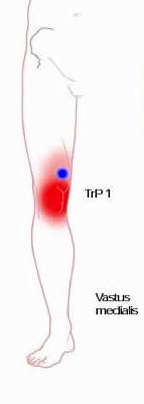One day you go for a run like any other day.
But after you finish, you notice a vague aching, weird kind of pain over the front of your right knee. You figure you just over did it and move on.
But then the next day, when you go for another run, this unwelcome knee pain shows up again.
And it doesn’t go away either. Despite ice, a knee strap, massage, Advil and a change of shoes, this new pain persists.
So, you break down and go see your family doctor.
When you go to your doctor, what happens?
Usually your doctor starts asking you some questions, pokes and prods your knee, moves it around. The whole thing takes less than about 10 minutes. If you don’t have anything ominous, like cancer or some other unusual disease, and you don’t have any kind of recent trauma like having been struck by a bat or a car or fallen off your roof, your “diagnosis” will be “knee pain”.
But since, your knee pain started right after you had finished a run, for example, then the diagnosis might be “tendonitis” or “runner’s knee” or “lateral tracking patella”.
You get a prescription for anti-inflammatories, are told to stop running and you should be fine in two or three weeks.
Three weeks go by but, you’re not okay. You feel okay walking around, going up and down stairs and doing everyday things but you can’t exercise or run without knee pain.
So, now what?
A Common Problem
I used to tell my students that you can’t diagnose something you’ve never heard of or seen.
That’s one of the reasons that we call it “practice”. As a clinician, you learn from the people you see who have problems that cause you immense frustration.
I learned about this common problem a long time ago while helping a young woman solve a perplexing case of anterior knee pain.
I was stumped. Her history, she was a runner and had a story very similar to the above, was consistent with a tendon injury – the patellar tendon. She was tender to pressure on the tendon, she hurt all around the tendon, everything pointed, practically shouted, HEY, DOPEY! THIS IS A TENDON INJURY!
But none of my solutions helped and I knew a lot about tendons.
So, I had to do some research and at the risk of sounding like that old guy who says, “Yeah, well in MY day, we had to…”, there was no Internet. Gasp. Holy crap, what did you do? How did you find anything?
Yeah, I know. Old school. Text books. The library. Did I mention I had to walk through three feet of snow barefoot?
I found something that sounded very similar. There was hope. And the treatment seemed plausible.
The problem was oddly simple. It was so simple I couldn’t believe that it really was true. Of course, it wasn’t a study. So, I was skeptical but at this point, I had nothing to lose. It wouldn’t make her any worse and who knows, it might work.
It turns out that a common source of anterior knee pain is one or more trigger points in the quadriceps muscle specifically the  rectus femoris (RF) or the vastus medialis oblique (VMO).
rectus femoris (RF) or the vastus medialis oblique (VMO).
Self-Care
When you press on an active trigger point, the point will be painful but you’ll also feel pain in the area of your primary complaint. So, in this case, when you press on the trigger point within the VMO, you’ll feel a painful sensation around the front of the knee and/or the inside.
There are a number of treatments for trigger points which is beyond the scope of this post, however, a simple and often effective way to deal with a trigger point is to use a sustained pressure – a finger or thumb. But it’s not a forceful pressure. You press slowly until you begin to feel some discomfort. At that point, hold the pressure until it subsides – usually a minute or so. Then increase the pressure, slowly, until you feel discomfort again. Now, hold the pressure until it subsides. Repeat this about five times at which point you’ll probably be delivering a lot more pressure to feel the discomfort. Time to stop.
Sometimes you’ll feel the muscle twitch or jump which is normal and a good thing but don’t get concerned if it doesn’t happen. As long as the pressure tolerance increases, you’re helping the problem.
Typically, a few sessions will inactivate the trigger point. But if that doesn’t work, then you may need more invasive treatment (such as needling or an injection).
Why This Matters To You
If you know that a possible cause for your anterior knee pain could be a trigger point, you can ask your therapist / provider about it.
The thing to remember though is that it’s quite possible that your knee pain could be caused by more than one thing which is why it’s nearly impossible to diagnose yourself even if you know what you’re doing (I’ve seen clients with, for example, a combination of patellar tendonosis, VMO trigger point and articular cartilage disease for example).
Trigger points are common and quite vexing but they are something you can overcome.

